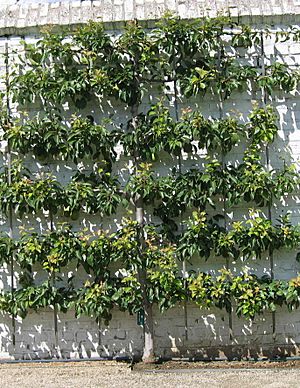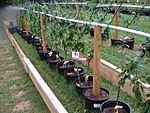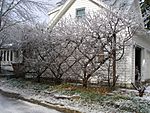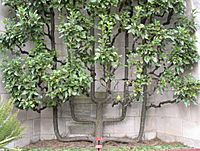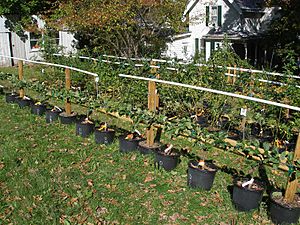Espalier facts for kids

Espalier is a special way of growing plants, especially fruit trees. It involves carefully shaping a woody plant by pruning (cutting branches) and tying its branches to a frame. This makes the plant grow flat against a wall, fence, or a special support called a trellis. It's like making a living piece of art out of a tree!
People use espalier not just for decoration, but also in gardens where there isn't much space. In places with mild weather, espalier plants can grow next to a wall. The wall reflects more sunlight and stays warm at night. This helps the fruit ripen better and extends the growing season.
A simple way to train an espalier is to have a main stem with branches growing straight out to the sides. You can make a branch grow more by training it upwards. Later, you can make it grow less and produce more fruit by training it to grow flat.
Contents
History of Espalier
The word espalier comes from French, which got it from the Italian word spalliera. This means "something to rest the shoulder against." Long ago, in the 1600s, the word only meant the frame or trellis itself. But over time, it came to mean both the way of shaping plants and the plants that are shaped this way.
The idea of espalier started with the ancient Romans. In the Middle Ages, people in Europe became very good at it, turning it into an art form. It was popular to grow fruit trees this way inside castle courtyards. This allowed them to have fruit without taking up too much open space. It also helped decorate plain walls. Farmers have used this method for hundreds of years to grow grapes in Vineyards.
What is a Belgian Fence?
A Belgian fence is a cool way to make a living fence out of trees. To create one, you cut a young, thin tree down to about 38 to 45 centimeters (15 to 18 inches) above the ground. You let only the top three buds grow. One bud in the middle grows straight up, and the other two grow into a "V" shape. You remove any other buds.
Once the middle stem is removed, you have a single V-shaped espalier. To make a Belgian fence, you plant many of these V-shaped trees in a line, about 60 centimeters (two feet) apart. Their branches are trained to cross over each other, creating a crisscross pattern.
This V-shape is a starting point for many other espalier designs. For example, you can lower the branches to grow horizontally (called a "Step-over" design). Or you can train them into a "Fan" shape. You can even create multiple levels of horizontal branches, making a "Horizontal T" design.
Best Plants for Espalier
While almost any woody plant can be shaped this way, some types of trees and shrubs work better for espalier than others. This is because their branches are easier to train.
A good example is training an apple or pear tree into a "Horizontal T" shape. In spring, you prune the tree to the lowest wire, about 38 to 45 centimeters (15 to 18 inches) above the ground. During summer, new buds grow into branches. You train one branch to grow straight up to the next wire, while others are trained along the wires. Any unwanted buds are removed. In autumn, the side branches are lowered and tied to the wires. The next year, you create another level in the same way.
Here are some examples of plants that work well for espalier:
- Trees:
- Acer palmatum Japanese Maple
- Cercis canadensis Redbud
- Citrus spp. Lemon, Orange, Tangerine, etc.
- Coccoloba uvifera Sea grape
- Eriobotrya japonica Loquat
- Euonymus alata Winged Euonymus
- Ficus carica Fig
- Forsythia intermedia Forsythia
- Ilex spp. Hollies, especially Ilex cornuta 'Burford' Burford holly
- Lagerstroemia indica Crape myrtle
- Magnolia grandiflora Southern magnolia
- Magnolia stellata Star Magnolia
- Malus spp. Apple, Crabapple, etc.
- Olea europia Olive
- Prunus spp. Peach, Nectarine, Plum, Almond, etc.
- Pyrus spp. Pear
- Taxus sp. Yew
- Shrubs:
- Camellia japonica and C. sasanqua Camellia
- Carissa grandiflora Natal plum
- Chaenomeles lagenaria Chinese flowering quince
- Cotoneaster sp. Cotoneaster
- Gardenia jasminoides Gardenia
- Juniperus spp. Juniper, especially Juniperus × pfitzeriana' Pfitzer juniper
- Ligustrum japonicum Privet
- Osmanthus fragrans Sweet Olive
- Photinia glabra Redtip photinia
- Photinia serrulata Chinese Photinia
- Podocarpus spp. Podocarpus
- Pyracantha spp. Firethorn, especially Pyracantha coccinea Pyracantha coccinea
- Stewartia Koreana Korean Stewartia
- Viburnum sp. Viburnum
- Woody vines:
- Allamanda cathartica Allamanda
- Ficus pumila Creeping fig
- Jasminum nudiflorum Winter Jasmine
- Pyrostegia venusta Flame vine
- Trachelospermum jasminoides Confederate jasmine
Espalier Designs
Espalier designs often use traditional patterns that have been around for hundreds of years. But you can also create more modern, free-form designs. Sometimes, a plant that already has an interesting shape is perfect for an informal espalier.
Here are some common formal espalier patterns:
- V Shaped: The tree is cut low, about 38 to 45 centimeters (15 to 18 inches) from the ground. Two buds grow into branches that are tied to supports, forming a "V" shape. This V-shape is the first step for many other designs.
- Belgian Fence: Several V-shaped espaliers are planted close together, about 60 centimeters (two feet) apart. Their branches cross over each other and are tied to a trellis, making a living fence.
- Stepover: This is a horizontal espalier with only one set of branches. These branches are tied to a wire about 38 centimeters (15 inches) above the ground. You start with a V-shape, then lower the branches to the bottom wire by autumn of the first year. This design can be created quickly.
- Horizontal T (or Horizontal Cordon): Branches are trained horizontally along wires that are spaced evenly. You start with a V-shape, but a third bud is trained straight up to the next wire. The other two branches are trained like a stepover. In the spring of the second year, you prune the vertical stem to the second wire and create another V-shape. This takes one year for each level.
- Palmette (or Fan): Branches grow outwards like a fan. This is made by cutting back the branches of a V-shaped espalier and lowering them slightly. Many new branches are encouraged to grow and are tied to a trellis in a fan shape.
- Baldassari Palmette: A specific palmette design created around 1950, mostly used for training peach trees.
- Cordon: This design has a main stem with short branches that produce fruit. These are tied to a fence or wire trellis. A single vertical or angled cordon is one of the simplest and quickest espalier types. An angled cordon helps control how much the tree grows and increases fruit production.
- Verrier Candelabra: A type of vertical cordon with several upright stems, usually starting from a V-shape.
- Drapeau Marchand: A cordon trained at an angle, with branches on its upper side growing out at a right angle from the main stem.
- U Double (and other U-shaped espaliers): These are just different ways of saying "double vertical cordon."
Setting Up and Caring for Espalier Plants
When you plant espalier trees against a solid wall, you usually put them about 15 to 30 centimeters (6 to 12 inches) away from the wall. This gives the roots space to grow and allows air to move around the plant, which helps prevent pests.
First, you install supports for the wires that will guide the plant's growth. If the wall is made of brick or stone, you can put special bolts or screws directly into the mortar joints. For wooden walls, you might use different types of fittings.
You can find healthy plants, about 90 to 120 centimeters (three to four feet) tall, at most plant nurseries. Some might even come with trellises already attached. These plants are great for espalier if their shape is already somewhat flat. All you need to do is plant them.
If you get a plant that hasn't been pruned yet, it's good to let it settle in after planting. Then, you can slowly start pruning it into the flat shape you want. Major pruning is usually done when the plant is not actively growing (dormant). For flowering plants, you prune them during the right season for that type of plant. Bending and training the branches into your design is best done during the summer, when they are most flexible.
Other Ways to Shape Trees
- Bonsai: This is the art of growing small trees in pots, shaping them to look like full-sized trees in nature.
- Grafting: A gardening trick where you join parts of two or more plants together so they grow as one.
- Pleaching: A method of weaving tree branches together to create a dense, living fence or screen.
- Topiary: The art of clipping shrubs and trees into decorative shapes, like animals or geometric forms.
- Tree Shaping: A creative way to grow living trees into structures, furniture, or art.
See also
 In Spanish: Espaldera para niños
In Spanish: Espaldera para niños


